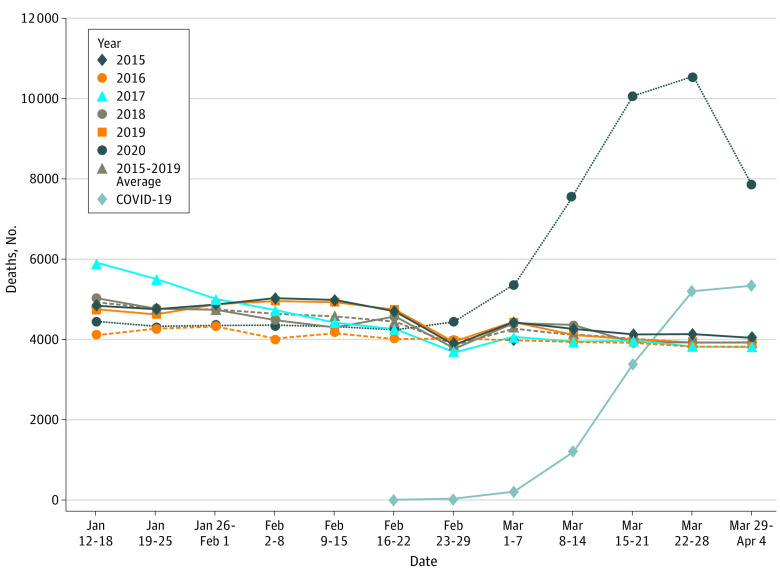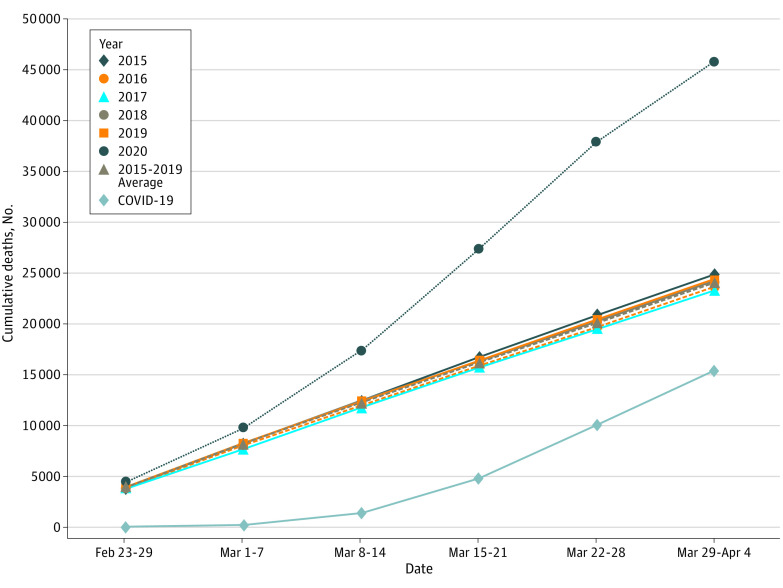Abstract
This analysis compares reported deaths from COVID-19, February 23 to April 4, 2020, and total mortality in Italy from January 12 through April 4 in the years 2015 through 2020.
Soon after the first patients with coronavirus 2019 (COVID-19) were diagnosed in Italy in February 2020, a severe epidemic developed.1 The greatest concentration of cases has been in Lombardy, a region of northern Italy with a population of 10 million in 2019. As of the end of April 2020, there had been 27 682 reported deaths from COVID-19 in Italy, compared with 26 097 in the UK, 24 543 in Spain, 4637 in China, and 60 966 in the US.2
In many countries, there is concern that the number of reported deaths from COVID-19 substantially understates the actual increase in mortality that may be directly or indirectly associated with the pandemic.3 We compared the number of reported deaths from COVID-19 in Italy and the increase in total mortality.
Methods
We obtained the number of reported COVID-19 deaths in Italy from the National Health Authority.4 Deaths are reported for patients who tested positive in hospitals and a few nursing homes. Reported COVID-19 deaths do not include people who died at home or in care facilities where testing was not performed. We obtained preliminary mortality data for January 12 to April 4, 2020, from the Italian National Institute of Statistics, for 1689 Italian municipalities (21.4% of the country).5 These municipalities are those with more than 10 deaths and where mortality increased by 20% or more between March 1 and April 4, 2020.5 We compared the preliminary totals of deaths in 2020 with the average annual number of deaths in these municipalities during the same time period in 2015 through 2019.5 We calculated the weekly number of deaths over the 3-month period as well as the distribution according to age and sex. We used StatView 5.0 (SAS Institute Inc) for statistical analyses.
Results
Starting in late February 2020, the number of COVID-19 deaths increased weekly, and then plateaued during the week of March 29 to April 4 (Figure 1). Total annual mortality for March and early April was similar for 2015 through 2019 (average 20 214 deaths per year). For March 1 to April 4, 2020, however, there were 41 329 reported deaths, a 104.5% increase compared with the average number of deaths for the prior 5 years (Figure 2).
Figure 1. Overall Number of Deaths Reported in Italy During the January 12-April 4 Period, 2015 Through 2020.
Deaths were counted among 1689 municipalities, and reported deaths from COVID-19 during the same period.
Figure 2. Cumulative Number of Deaths Reported in Italy During the February 23-April 4 Period, 2015 Through 2020.
Deaths were counted among 1689 municipalities, and reported deaths from COVID-19 during the same period.
For each year from 2015 to 2019, men had lower numbers of deaths than women for March and early April (on average 9395 and 10 819 deaths per year, respectively). For March 1 to April 4, 2020, however, there were 21 266 deaths among men and 20 063 among women. Compared with the average number of annual deaths in the prior 5 years, the increase was 126.4% for men and 85.4% for women. For people aged 65 to 74 years, there were 5417 deaths between March 1 and April 4, 2020, compared with the average number of 2566 annual deaths in the prior 5 years (111.1% increase). For people aged 74 years and older, there were 32 829 deaths in 2020 compared with the average number of 15 677 annual deaths in the prior 5 years (109.4% increase).
Of the 41 329 reported deaths from March 1 to April 4, 2020, 19 824 were in Lombardy. Compared with the same period in 2019, there were 12 576 more deaths in 2020 than in 2019 (7248 deaths, increase of 173.5%). For men, deaths increased from 3328 in 2019 to 10 415 in 2020 (213.0%) and for women from 3920 to 9409 (140.0%).
Discussion
Our findings show that the official count of COVID-19 deaths in Italy has substantially understated the actual increase in mortality related to the pandemic, as is the case in other countries.3 There may be several explanations, including additional deaths directly related to the virus, deaths related to underlying health conditions exacerbated by the virus, and delayed care from the avoidance of hospitals or the demands on hospitals of caring for COVID-19 patients. The differences for men, for people 65 years and older, and for the Lombardy region are particularly noteworthy. A limitation is that the official count of COVID-19 deaths could be revised as additional data are reported.
References
- 1.Boccia S, Ricciardi W, Ioannidis JPA. What Other Countries Can Learn From Italy During the COVID-19 Pandemic. JAMA Intern Med. 2020. Published online April 7, 2020. doi: 10.1001/jamainternmed.2020.1447 [DOI] [PubMed] [Google Scholar]
- 2.Roser M, Ritchie H, Ortiz-Ospina E, Hasell J Coronavirus (COVID-19) Deaths. Accessed May 8, 2020. https://ourworldindata.org/covid-deaths.
- 3.Wu J, McCann A, Katz J, Peltier E 109,000 Missing Deaths: Tracking the True Toll of the Coronavirus Outbreak. Accessed April 22, 2020. https://www.nytimes.com/interactive/2020/04/21/world/coronavirus-missing-deaths.html.
- 4.Ministero della Salute Covid-19, indagine di sieroprevalenza. Accessed May 8, 2020. http://www.salute.gov.it/nuovocoronavirus
- 5.Istituto Nazionale di Statistica Rapporto sulla mortalità della popolazione residente a cura di iss e istat. Accessed June 16, 2020. https://www.istat.it/it/archivio/242149




